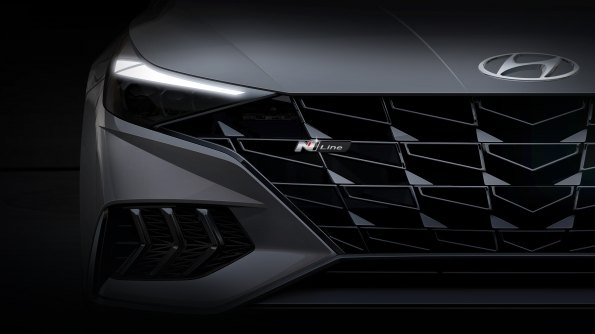Sport, Redux: Hyundai Elantra N Line Emerges From Shadows

There’s an all-new Hyundai Elantra arriving for 2021, and not a moment too soon. Your author was not a fan of the 2019 refresh, though the basic package remained as competent as before, if a little boring. And the new-generation sedan retains that basic thrift and utility, but not every Elantra driver longs for a life of numbing okay-ness.
That’s where the N Line comes in.
Replacing the previous Elantra Sport, the N-Line variant follows the same rule book as before, only this time takes its name from the division behind the hot Veloster hatch that happens to carry that magic letter. “N Line” just means an improvement over stock, with many of the go-fast exterior bits seen on a full N.
The sedan’s Elantra GT cousin received the N Line treatment for 2020.
Looking just as sharply creased as its stock sedan stable mate, the Elantra N Line dials up the meanness with a more aggressive front and rear fascia. The grille mesh changes form and dons an N Line badge in the left corner, while side scoops open up, each punctuated by three arrow-shaped fins. Hyundai claims these air intakes are inspired by motorsport. Sure, why not.
Side skirts telegraph the sedan’s sporting nature to passers-by, with the gloss black coating the side mirrors, window sill trim, and said skirts lending the model further badass-ification (but not so much that non-Honda intenders run scared). Wheels are 18 inches in diameter. Out back, twin exhaust pipes protrude from the “diffuser.” This isn’t the type of car where a prospective driver calculates pounds of downforce and coefficient of drag, and Hyundai deserves kudos for not tacking on anything taller than the subtle lip spoiler seen here, as well as going easy on the boy-racer urge.
It’s a fairly sharp-looking package meant to rival such products as the Honda Civic Si, with power to match. Hyundai didn’t reveal specs Wednesday; rather, it just really felt enthusiastic about its as spooky renderings. It’s assumed the powertrain from the Elantra Sport will carry over here, with a turbocharged 1.6-liter four-cylinder making 201 horsepower and 195 lb-ft, or close to it. The Civic Si boasts 205 hp and 192 lb-ft.
One hopes that the six-speed manual transmission, which disappeared from the Elantra Sport for 2020, stages a return. A seven-speed dual-clutch will otherwise be the only available gearbox.
Like its predecessor, the Elantra N Line’s job is to serve as value alternative to Japanese offerings in the same segment. We’ll know more about how well this Korean player stacks up when Hyundai gets around to debuting the model in full.
[Images: Hyundai]

More by Steph Willems
Latest Car Reviews
Read moreLatest Product Reviews
Read moreRecent Comments
- Rochester Tim, where was your head at in 1984 when it became a law to wear your seatbelt? Personally I thought it was none of the Gubmint's bizniss to force me to belt up. Today, I feel exposed and unsafe without it. My point is, give it time, both the tech and your values will evolve.
- Theflyersfan After looking it over, Honda, I want royalties for this one: The Honda Yawn.
- V8fairy Not scared, but I would be reluctant to put my trust in it. The technology is just not quite there yet
- V8fairy Headlights that switch on/off with the ignition - similar to the requirement that Sweden has- lights must run any time the car is on.Definitely knobs and buttons, touchscreens should only be for navigation and phone mirroring and configuration of non essential items like stereo balance/ fade etc>Bagpipes for following too close.A following distance warning system - I'd be happy to see made mandatory. And bagpipes would be a good choice for this, so hard to put up with!ABS probably should be a mandatory requirementI personally would like to have blind spot monitoring, although should absolutely NOT be mandatory. Is there a blind spot monitoring kit that could be rerofitted to a 1980 Cadillac?
- IBx1 A manual transmission



































Comments
Join the conversation
Front and back look great to me, side view is a strong no. Wheels and band aid tires suggest Hyundai continues to be tone deaf about the importance of a decent ride and road noise suppression (I used to own an Elantra Sport).
This sedan makes what Detroit is producing look rather bland in comparison. I have a suggestion for GM. Instead of cancelling the Malibu why not try to make it competitive with this Elantra. The Malibu is already a pretty decent sedan. It would be wise to further upgrade the Malibu and stop wasting resources on EVs few will buy. If GM does not change its ways they will find themselves with only a 15% market share in the US.